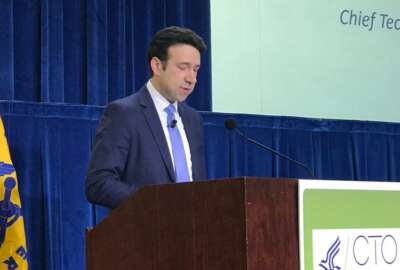
DoD CIO gets beefed-up authorities, responsibilities starting Tuesday
Law taking effect Jan. 1 gives the Defense Department chief information officer new authorities over military services' "disparate" IT modernization efforts.
The Pentagon’s chief information officer woke up Tuesday morning with a good deal more power and influence than he had the day before.
New legal provisions Congress set to take effect in the new year give the Defense Department chief information officer a variety of additional authorities to set IT standards for all of the military services and to scrutinize their budgets.

The amendments also return the DoD CIO’s status to one that requires Senate confirmation. That hasn’t been the case since 2012, when the department restructured the office and did away with the title of assistant secretary of Defense for Networks and Information Integration. Although the next CIO will have to be presidentially-appointed and confirmed, the law also allows for the incumbent CIO, Dana Deasy, to continue to serve without undergoing a confirmation process.
Going forward, the new law puts the CIO in charge of “developing, adopting, or publishing” standards for all of the IT and cyber capabilities that run on the military services and Defense agencies’ networks. It bars DoD organizations from buying or developing technologies that won’t adhere to those standards, and tells the CIO to draw up “mitigation plans” for systems that already do not.
Secondly, the CIO will now conduct in-depth examinations of each defense organization’s five-year budget before they go to the DoD comptroller’s office for a final review. The DoD CIO will have to determine whether the services and agencies’ spending plans are adequate to meet their actual IT and cyber needs, and highlight any gaps in a report to the secretary of Defense. Then, the secretary must send a similar report to Congress detailing and explaining those “inadequacies.”
Some of the changes dovetail with the Federal Information Technology Reform Act, the 2014 law in which Congress tried to strengthen the role of CIOs across government.
In the House Oversight and Government Reform Committee’s latest Federal IT Acquisition Reform Act scorecard, the Defense Department earned an overall grade of “D+.” Within the assessment’s subcategories, DoD got high marks by virtue of the fact that its CIO reports directly to the secretary, but a dismal score on one measure of its IT oversight: the OMB-directed PortfolioStat process yielded savings of only 0.9 percent within the department.
Related Stories
“The existing authorities of the CIO are insufficient to address the multitude of management challenges across the Department of Defense information environment,” members of the Senate Armed Services Committee wrote in a report accompanying their version of the bill. “Countless efforts across the Department of Defense are plagued by poorly enforced standards and a CIO position whose policy and guidance are largely considered as advisory by the services. As a result, each service continues to pursue disparate information technology and business systems efforts.”
As an example, the Senate pointed to DoD’s implementation of a multi-year technology standardization effort known as the Joint Information Environment.
“Two of the services have largely agreed to adopt standards for implementation, yet the Navy has only agreed to support the ‘spirit and intent’ of this foundational effort for implementing a defendable department-wide infrastructure,” the committee wrote. “The information environment challenges do not end with the acquisition of information technology. Space and cyber are equally under-prioritized and require an organizational construct that recognizes information dominance as a critical element of warfighting.”
The new CIO authorities are only one significant legal change taking effect New Years Day.
Changes to military justice
Also going on the books is the largest update of the military justice system in decades. Congress passed a series of changes in 2016, largely at the Defense Department’s request, but delayed their effective date until now. They include changes to the number of panelists on military juries, increased pre-court martial authorities for military judges, and some changes to the offenses for which military members can be court martialed.
Another change taking effect Tuesday: The tenure of the chairman of the Joint Chiefs of Staff is no longer in doubt.
Previously, he or she served for a two-year term, and could be re-nominated by the president to serve a second one. Going forward, the chairman will be nominated and confirmed for a single four-year term — and potentially longer during a time of war. It also would let the same general or admiral serve for a combined eight years as vice chairman, and then chairman, if the president determines those back-to-back four year appointments are “in the national interest.”
Copyright © 2025 Federal News Network. All rights reserved. This website is not intended for users located within the European Economic Area.
Jared Serbu is deputy editor of Federal News Network and reports on the Defense Department’s contracting, legislative, workforce and IT issues.
Follow @jserbuWFED






